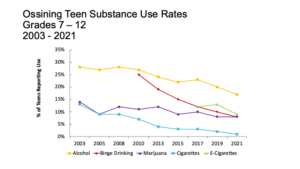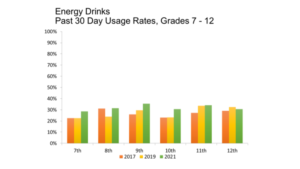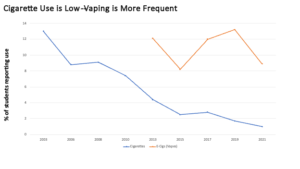Teen Substance Use in Ossining

There is a lot of good news about use in Ossining but there is still more to do.
We can all take pride in the fact that we have made huge strides in Ossining to reduce underage use. Among middle and high school students:
- Drinking rates are down
- Marijuana use is down
- Binge drinking is down
- Cigarette use is down
Social norms are the behaviors and attitudes that are most common in a group. As a group-oriented species, we often use what is perceived as the “normal” behavior or attitude to guide our choices and shape our personality. Research shows that our perception of our peers, particularly when it comes to high-risk behavior, does not match reality. We overestimate the extent of our peers’ risky choices and underestimate their preference for healthy choices.
It is important to reinforce with young people that most kids don’t use, giving them confidence in their choices and reaffirming that they are far from alone in refusing drugs and alcohol.
Some Trends in Ossining Present Challenges
Despite progress over the years and some promising trends, there is more to do to prevent underage substance use in Ossining. Student data from December 2021 shows some noteworthy findings.
- Alcohol use is higher in Ossining than national averages. Ossining students report having used alcohol in the past 30-days at rates up to 27% higher than national statistics, depending on the grade.
- Kids get and drink alcohol close – too close– to home. While most kids report not drinking, among those that do, they get and use alcohol close to home. Parents and families have a big role to play in making sure young people don’t get or use alcohol.
When asked how they get alcohol
20% get if from someone they know
20% get it from home with parents’ permission
20% get it from home without parents’ permission
When asked where they drink alcohol
43% drink at their own or at someone else’s home without parent’s permission
32% drink at their own home with parent’s permission
**Westchester County has a social host law that holds parents liable for allowing gatherings where minors consume alcohol – even if they don’t provide it.**
- Kids who use substances are starting very young. The surveys show that young people who have ever used any substance started at an alarmingly young age, around age 13 or 14.
Ideally, alcohol and drugs should be totally avoided and even trying them should be delayed as long as possible. In addition to the very real physical and mental health dangers of substance use (including its impact on the family and social life of a young person), young brains are still developing. Substance use interferes with this brain development and the effects can be long-lasting.

-
- Energy drinks are widely used. Energy drinks are the number one substance used by Ossining’s students. They are included in the survey because many of them contain large amounts of caffeine and/or pharmaceutical grade caffeine that can cause health problems or disrupt sleep cycles, according to the Center for Disease Control. Scientific evidence is growing that energy drinks (ex., Red Bull, Monster, Rockstar, 5-Hour-Energy) can have serious health effects particularly in young people. They often contain very high amounts of sugar. Mixing them with drugs or alcohol is especially dangerous.

- Vaping exposes users to nicotine addiction and other health risks. Click here to learn more about nicotine and vaping.
The survey shows that only 71% of students think that using e-cigs risks harming their health; that means almost 30% don’t see the risk!
Risk and Protective Factors
To prevent a problem, we need to identify the factors that increase the risk that the problem will develop and find ways to reduce the risk.
Risk factors are characteristics of school, community, and family that are known to increase the likelihood of drug use or other unhealthy, negative behaviors. For example, children who have ready access to drugs and alcohol are more likely to begin using them. Protective factors on the other hand, provide a positive influence on young people and decrease the likelihood of substance use and other problem behaviors. Having strong bonds to a healthy set of values is an example of a protective factor. It is important to note that risk and protective factors are not a guarantee of an outcome for any individual, rather, they tend to increase the likelihood.
The data about risk and protective factors in Ossining is mixed. The good news is that our community is host to plenty of protective factors. We can work together to strengthen and sustain those characteristics that protect young people.
For example, young people in Ossining report comparatively high levels of “prosocial involvement” meaning that others notice and commend them for doing a good job, show pride when they do something well and encourage them to do their best.
At the same time, a significant number of young people surveyed said they had depressive symptoms (feeling down), and some kids reported thinking they would be seen as cool for drinking or using marijuana, or not liking school. These factors are linked to potential unhealthy behaviors, including substance use.
Prevention
The essence of prevention is to use the information we have about teen substance use to prevent it in the first place. Ossining Communities that Care and its members design education, trainings, and programs for young people and their families that address the actual needs of the community.
What can you do?
- Talk to your kids about substance use and other risky behaviors
- Learn more about Ossining Communities that Care
- Get Involved!
ABOUT THE DATA
The information about students in Ossining comes from the students themselves: they are surveyed regularly to assess their behaviors and exposure to risk and protective factors that influence the likelihood of academic success, substance use, and other outcomes.
How valid are the survey results? Very! The survey is anonymous and confidential. In addition, researchers who analyze the data take care to review responses for signs of dishonest responses and remove them.